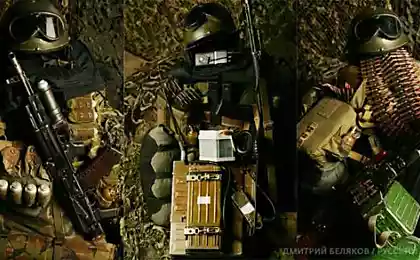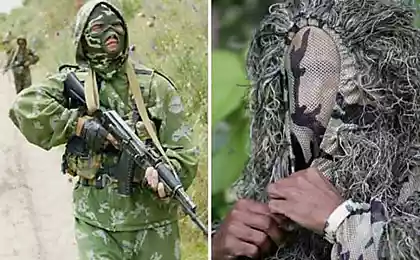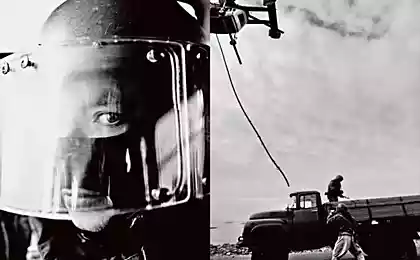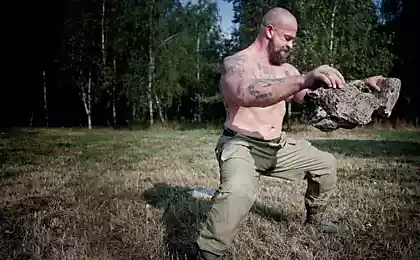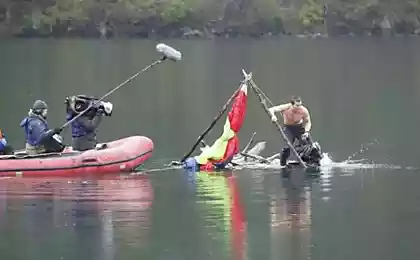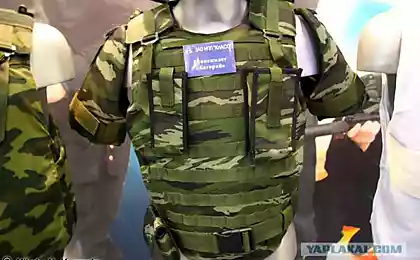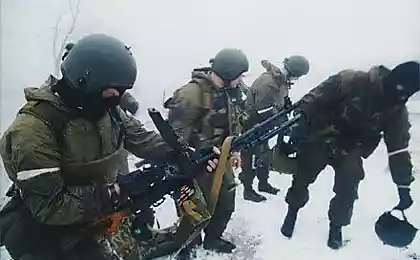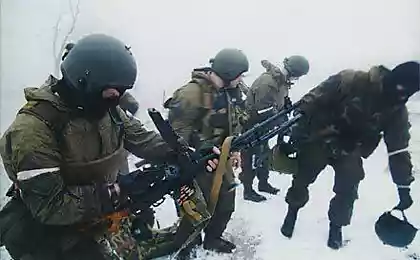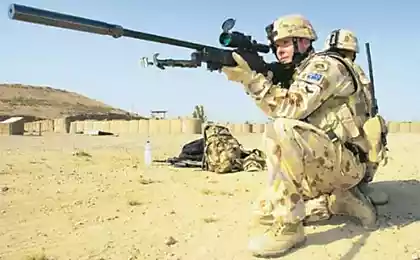664
Torn hunting British special forces
Vladimir Shcherbakov
Unsuccessful SAS operation to destroy the Argentine attack aircraft "Super Etendard»
The history of the special services of any country contains both bright and unforgettable successes and bitter, sometimes totally unpredictable failures. Both are scrutinized by both the "culprits" and their colleagues or opponents of the special services of foreign states. I do not avoid failure and one of the most famous and elite special forces of the world - the British Special Aviation Service.
GETTING STARTED - PLANES
In 1982 came the turn of the South Atlantic to become a "hot spot" of the planet: around the Falkland Islands and South Georgia turned a real war. After the Argentine troops suddenly landing on these islands and in a matter of hours broke the resistance of defending their garrisons, all the answer came a rearing "British Lion".
Perhaps the main threat to the British Expeditionary Force, prepare to launch an operation to liberate the Falkland Islands, the Argentine attack planes were "Super Etendard", armed with the latest at the time the French anti-ship missiles "Exocet". And this threat was so high and so real that the British command decided to neutralize the aircraft carrier before the start of the main phase of the operation. Entrusted with this difficult task in the special forces SAS (Special Air Service - Special Aviation Service).
According to aviation photo-reconnaissance and information intelligence intelligence, "Super Etendard" appeared regularly at the airport jump at the Rio Grande (located in the Argentine part of the island of Tierra del Fuego) or on the air base Río Gallegos (Rio Gallegos), on the continental Argentina - roughly at the latitude of the Falklands and in a little more than 300 km to the west of them.
The plan involved the sabotage operation the following steps.
Reconnaissance and Sabotage SAS Group consisting of eight soldiers had to land as close as possible to the Rio Grande, secretive approach to the airfield and disable all there are storm troopers "Super Etendard" with explosives. The group had to move in a pre-designated area, where they were to pick up a helicopter or helicopters (depending on the current situation).
In that case, if the commandos failed to get to the airport, the group had a backup plan: the fighters had to take up positions along the runway of the airport of Argentine and try to bring down the soaring "Super Etendard" using MANPADS. Of course, in this case, their chances of a successful separation from the prosecution and returning home abruptly rushed to zero.
Evacuation sabotage SAS Group with the Argentine coast: true photographing participants.
Photography UK MoD
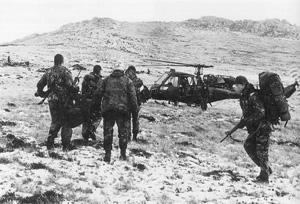
The one helicopter, which was designated for dropping reconnaissance and sabotage groups in the Tierra del Fuego, the fate of the well was to be not very enviable: a very, very small residues of fuel crew, consisting of three military naval aviation of the Royal British Navy, would have to try " hold on "to the territory of Chile, where it was necessary to sit down, and then burn the helicopter. After that action had to be brought had a separate plan - the evacuation of the three helicopter.
Made a blunder ...
"The noise inside was deafening helicopter and unbearable. Sealed protection cabin of the helicopter, which reduces a lot of noise coming from the engine, in this case, was removed before take-off - in order to reduce as far as possible take-off weight of the machine. They were removed from the cabin of the helicopter and the seat. The commandos of the SAS Group sat on the floor of the helicopter cargo and passenger cabin, surrounded by their special equipment, - later recalled one of the corporals division "B" SAS Group, was directly involved in the operation. - The only thing that was good discernible in rattling the sweltering darkness lit only by tiny lights cockpit, so it is "passive" night-vision equipment, which put on the pilots. This allowed them to get enough bright, with a greenish tinge, image areas lying in the pitch darkness of the night ahead of the flight. Outside the SAS soldiers could discern a fluorescent wave crests of the South Atlantic, towering several feet below. Quiet and safe aircraft carrier deck, they left about an hour ago, and immediately after take-off the helicopter dropped almost to the wave crests, heading west toward the coast of Argentina ... »
Two of the commandos, colleagues, and called them Gibb Tough, performed measurements of the course and speed of the helicopter, recording data in their notebooks. The experience of previous landing commandos from helicopters taught that this question can not rely solely on pilots and further it is necessary to conduct their own navigational calculations, thus controlling helicopter. After all, if the special forces do not throw in the place where it is necessary, the operation will have to stop before it starts.
It should be noted as a criticism of the organizers, that the conduct of a special pre-training and training carried out was not. Although it was for objective reasons - the usual lack of time. However, experience obtained during the years of the previous special forces service, inspired as veterans remembered SAS, their confidence that this task will be completed successfully.
Dropping
Suddenly installed in the cockpit warning system radar illumination helicopter screamed sharply. So loudly that the signal is blocked him, even the noise of the engines, forcing all guard. The pilot dropped even a few feet closer to the water. The signal disappeared, but after a few seconds the system again "screeched." The pilot "dropped" the helicopter is even lower, so that the spray steel sweep over the glass cockpit of the helicopter.
The system finally, finally stopped - it meant that the Marines have become not visible Argentine coastal radar stations. Tension rose in the cockpit - in front of the exchange rate has become distinctively Argentine coast, dark mass silhouetted against the night sky.
The co-pilot of the helicopter turned and pointed a finger at his map, showing the place where, according to the calculations of the pilots, they are now. Gibb and Tough nods confirmed that it agrees with their calculations, and the tension eased a little. At least, they do not get lost. "Sea King" took over the surf, phosphorescent in the dark of night, flew over the beach and headed into the territory, still following at the lowest possible altitude - at the very limit of the pilots and helicopter.
The pilots had already flew on missions with special forces from SAS - both in training and in the fighting. But night vision devices were their new equipment. They were given before the dispatch of the British Expeditionary, so pilots almost did not have time to try them in action - they can swoop with them just a couple of hours.
Gibb leaned out the side door, "Sea King", overseeing navigation landmarks, making notes of their passage. He was confident that the pilots lead them in the right direction.
The pilot, meanwhile, chose a relatively flat portion of the surface for the landing and went on to decline.
"Tension rose again and became almost unbearable - he wrote later in his book" Ghost armies: The Secret History of SAS »a veteran of the Special Air Service Ken Connor. - "Point of no return" - it's always the worst moment in any operation, the last moments before you find yourself out of a helicopter and you're ready, barely touching the ground, run ahead. "
As soon as the wheels of the helicopter touched the ground, and Gibb Tough jumped out, but the commander of the group, let's call him Andy, still checked with the card. Suddenly he shouted something and the others nodded.
Gibb shouted back that everything is in order, and tried to "pull out" his "boss" of the helicopter, but he resisted, again pointing to a map. Commando climbed back to try to resolve this embarrassing misunderstanding, which arose at the most critical moment of the surgery. The remaining group of men became impatient and wonder looking at each other, waiting for the final decision. After waiting a few moments, Tough, too, he climbed back into the helicopter and heard Andy ordered the pilot to "move on to the west, we are not in the place where they should."
ERROR
Helicopter again soared into the air and flew ultra low further west. The second pilot continued to look at Andy, being surprised that they were ordered to fly farther away from the place, which he considered the best, but the commander of the Special Forces teams had the final word here. So all were forced to submit.
A few minutes later, Andy pointed down, a moment later, "Sea King" again touched the ground, and the commandos jumped out. Over the next few seconds, the helicopter disappeared in a westerly direction, soon his crew put the car and left it on the beach, Aqua-Fresco (Aqua Fresca), 10 miles south of the Chilean Air Force base in Punta Arenas (Punta Arenas), a large city on the peninsula of Brunswick, on the west coast of the Straits of Magellan.
Immediately after the landing of commandos tried to clarify its location, but within sight there were no specific guidelines - only an endless plain, disappearing into an endless dark distance. The only sounds were the only rapidly weakening noise of the engines, "Sea King" and the howling of the wind blowing from the west.
Tough and Gibb started a squabble with Andy, asking why they flew away from the place that everyone else thought the correct position. But Andy continued to insist that he was right. However, the dispute had to be postponed - it is now overriding the implementation of the task. Each of the commandos began immediately to work, trying to determine where they are relative to their desired airfield.
In the end, the commander decided to divide into groups of commandos, two, and they spent the rest of the night out to find at least some landmark to yet determine their location. With the first rays of the sun commandos regrouped. None of them found nothing, they did not orient. The point, as they say, the smell of kerosene.
Then the commander of the group included satellite communications equipment and reported about the problem in the SAS headquarters in Hereford (Hereford; city in the UK, about 80 km south-west of Birmingham). But the only advice he got from a distance of 9000 miles - is yet to find some way some guidelines and then - still carry out the task entrusted to them.
END OF OPERATIONS
The next couple of days commandos did nothing that day holed up in the shelter and the night continued to attempt to determine its location. In the end, they succeeded. It turned out that they are more than 50 miles west of the designated object to them.
Having defined its position, the group began to calculate the distance to the target and the time required to overcome it. Account is also taken at the time the remaining stocks of food and then see if they can after a long forced march still fulfill their combat mission. It turned out that the remaining commandos had water and food are not enough to reach the enemy airfield complete the task - to destroy the planes "Super Etendard" RCC "Exocet" - and then safely reach the collection point for evacuation.
The calculation results are transferred to Hereford, after which the group was ordered to stop operation, to advance to the border to meet with a special group of evacuation, which was instructed to return the SAS soldiers home to the UK.
After 72 hours, the soldiers landed in Hereford, but officers and experts of the planning group met returning from a very gloomy faces. Still, after they spent a few weeks to ensure that carefully to the smallest detail to develop the operation. The value of this task was very high, so it was necessary to find the cause of its complete failure. So the command of SAS immediately begin an official investigation.
The helicopter crew was firmly convinced - as well as most of the group - that they initially got into the right place, but the only person who had the right to make the final decision still took it and gave it a new command - turned out to be completely wrong .
"Diplomatic" Finally, conduct an investigation group was: at the moment of highest tension stress and Andy made a small navigation mistake. And in this small mistake in turn, led to disastrous consequences for the expeditionary force sent to the South Atlantic. The operation, which was to be another stunning and heroic chapter in the history of SAS, was closed and put on the shelf with a very unseemly haste.
Thus ended the first operation of the British SAS in the Falklands War - failed. Subsequently, they could be rehabilitated, but that's another story.
here
Source:
Unsuccessful SAS operation to destroy the Argentine attack aircraft "Super Etendard»
The history of the special services of any country contains both bright and unforgettable successes and bitter, sometimes totally unpredictable failures. Both are scrutinized by both the "culprits" and their colleagues or opponents of the special services of foreign states. I do not avoid failure and one of the most famous and elite special forces of the world - the British Special Aviation Service.
GETTING STARTED - PLANES
In 1982 came the turn of the South Atlantic to become a "hot spot" of the planet: around the Falkland Islands and South Georgia turned a real war. After the Argentine troops suddenly landing on these islands and in a matter of hours broke the resistance of defending their garrisons, all the answer came a rearing "British Lion".
Perhaps the main threat to the British Expeditionary Force, prepare to launch an operation to liberate the Falkland Islands, the Argentine attack planes were "Super Etendard", armed with the latest at the time the French anti-ship missiles "Exocet". And this threat was so high and so real that the British command decided to neutralize the aircraft carrier before the start of the main phase of the operation. Entrusted with this difficult task in the special forces SAS (Special Air Service - Special Aviation Service).
According to aviation photo-reconnaissance and information intelligence intelligence, "Super Etendard" appeared regularly at the airport jump at the Rio Grande (located in the Argentine part of the island of Tierra del Fuego) or on the air base Río Gallegos (Rio Gallegos), on the continental Argentina - roughly at the latitude of the Falklands and in a little more than 300 km to the west of them.
The plan involved the sabotage operation the following steps.
Reconnaissance and Sabotage SAS Group consisting of eight soldiers had to land as close as possible to the Rio Grande, secretive approach to the airfield and disable all there are storm troopers "Super Etendard" with explosives. The group had to move in a pre-designated area, where they were to pick up a helicopter or helicopters (depending on the current situation).
In that case, if the commandos failed to get to the airport, the group had a backup plan: the fighters had to take up positions along the runway of the airport of Argentine and try to bring down the soaring "Super Etendard" using MANPADS. Of course, in this case, their chances of a successful separation from the prosecution and returning home abruptly rushed to zero.
Evacuation sabotage SAS Group with the Argentine coast: true photographing participants.
Photography UK MoD

The one helicopter, which was designated for dropping reconnaissance and sabotage groups in the Tierra del Fuego, the fate of the well was to be not very enviable: a very, very small residues of fuel crew, consisting of three military naval aviation of the Royal British Navy, would have to try " hold on "to the territory of Chile, where it was necessary to sit down, and then burn the helicopter. After that action had to be brought had a separate plan - the evacuation of the three helicopter.
Made a blunder ...
"The noise inside was deafening helicopter and unbearable. Sealed protection cabin of the helicopter, which reduces a lot of noise coming from the engine, in this case, was removed before take-off - in order to reduce as far as possible take-off weight of the machine. They were removed from the cabin of the helicopter and the seat. The commandos of the SAS Group sat on the floor of the helicopter cargo and passenger cabin, surrounded by their special equipment, - later recalled one of the corporals division "B" SAS Group, was directly involved in the operation. - The only thing that was good discernible in rattling the sweltering darkness lit only by tiny lights cockpit, so it is "passive" night-vision equipment, which put on the pilots. This allowed them to get enough bright, with a greenish tinge, image areas lying in the pitch darkness of the night ahead of the flight. Outside the SAS soldiers could discern a fluorescent wave crests of the South Atlantic, towering several feet below. Quiet and safe aircraft carrier deck, they left about an hour ago, and immediately after take-off the helicopter dropped almost to the wave crests, heading west toward the coast of Argentina ... »
Two of the commandos, colleagues, and called them Gibb Tough, performed measurements of the course and speed of the helicopter, recording data in their notebooks. The experience of previous landing commandos from helicopters taught that this question can not rely solely on pilots and further it is necessary to conduct their own navigational calculations, thus controlling helicopter. After all, if the special forces do not throw in the place where it is necessary, the operation will have to stop before it starts.
It should be noted as a criticism of the organizers, that the conduct of a special pre-training and training carried out was not. Although it was for objective reasons - the usual lack of time. However, experience obtained during the years of the previous special forces service, inspired as veterans remembered SAS, their confidence that this task will be completed successfully.
Dropping
Suddenly installed in the cockpit warning system radar illumination helicopter screamed sharply. So loudly that the signal is blocked him, even the noise of the engines, forcing all guard. The pilot dropped even a few feet closer to the water. The signal disappeared, but after a few seconds the system again "screeched." The pilot "dropped" the helicopter is even lower, so that the spray steel sweep over the glass cockpit of the helicopter.
The system finally, finally stopped - it meant that the Marines have become not visible Argentine coastal radar stations. Tension rose in the cockpit - in front of the exchange rate has become distinctively Argentine coast, dark mass silhouetted against the night sky.
The co-pilot of the helicopter turned and pointed a finger at his map, showing the place where, according to the calculations of the pilots, they are now. Gibb and Tough nods confirmed that it agrees with their calculations, and the tension eased a little. At least, they do not get lost. "Sea King" took over the surf, phosphorescent in the dark of night, flew over the beach and headed into the territory, still following at the lowest possible altitude - at the very limit of the pilots and helicopter.
The pilots had already flew on missions with special forces from SAS - both in training and in the fighting. But night vision devices were their new equipment. They were given before the dispatch of the British Expeditionary, so pilots almost did not have time to try them in action - they can swoop with them just a couple of hours.
Gibb leaned out the side door, "Sea King", overseeing navigation landmarks, making notes of their passage. He was confident that the pilots lead them in the right direction.
The pilot, meanwhile, chose a relatively flat portion of the surface for the landing and went on to decline.
"Tension rose again and became almost unbearable - he wrote later in his book" Ghost armies: The Secret History of SAS »a veteran of the Special Air Service Ken Connor. - "Point of no return" - it's always the worst moment in any operation, the last moments before you find yourself out of a helicopter and you're ready, barely touching the ground, run ahead. "
As soon as the wheels of the helicopter touched the ground, and Gibb Tough jumped out, but the commander of the group, let's call him Andy, still checked with the card. Suddenly he shouted something and the others nodded.
Gibb shouted back that everything is in order, and tried to "pull out" his "boss" of the helicopter, but he resisted, again pointing to a map. Commando climbed back to try to resolve this embarrassing misunderstanding, which arose at the most critical moment of the surgery. The remaining group of men became impatient and wonder looking at each other, waiting for the final decision. After waiting a few moments, Tough, too, he climbed back into the helicopter and heard Andy ordered the pilot to "move on to the west, we are not in the place where they should."
ERROR
Helicopter again soared into the air and flew ultra low further west. The second pilot continued to look at Andy, being surprised that they were ordered to fly farther away from the place, which he considered the best, but the commander of the Special Forces teams had the final word here. So all were forced to submit.
A few minutes later, Andy pointed down, a moment later, "Sea King" again touched the ground, and the commandos jumped out. Over the next few seconds, the helicopter disappeared in a westerly direction, soon his crew put the car and left it on the beach, Aqua-Fresco (Aqua Fresca), 10 miles south of the Chilean Air Force base in Punta Arenas (Punta Arenas), a large city on the peninsula of Brunswick, on the west coast of the Straits of Magellan.
Immediately after the landing of commandos tried to clarify its location, but within sight there were no specific guidelines - only an endless plain, disappearing into an endless dark distance. The only sounds were the only rapidly weakening noise of the engines, "Sea King" and the howling of the wind blowing from the west.
Tough and Gibb started a squabble with Andy, asking why they flew away from the place that everyone else thought the correct position. But Andy continued to insist that he was right. However, the dispute had to be postponed - it is now overriding the implementation of the task. Each of the commandos began immediately to work, trying to determine where they are relative to their desired airfield.
In the end, the commander decided to divide into groups of commandos, two, and they spent the rest of the night out to find at least some landmark to yet determine their location. With the first rays of the sun commandos regrouped. None of them found nothing, they did not orient. The point, as they say, the smell of kerosene.
Then the commander of the group included satellite communications equipment and reported about the problem in the SAS headquarters in Hereford (Hereford; city in the UK, about 80 km south-west of Birmingham). But the only advice he got from a distance of 9000 miles - is yet to find some way some guidelines and then - still carry out the task entrusted to them.
END OF OPERATIONS
The next couple of days commandos did nothing that day holed up in the shelter and the night continued to attempt to determine its location. In the end, they succeeded. It turned out that they are more than 50 miles west of the designated object to them.
Having defined its position, the group began to calculate the distance to the target and the time required to overcome it. Account is also taken at the time the remaining stocks of food and then see if they can after a long forced march still fulfill their combat mission. It turned out that the remaining commandos had water and food are not enough to reach the enemy airfield complete the task - to destroy the planes "Super Etendard" RCC "Exocet" - and then safely reach the collection point for evacuation.
The calculation results are transferred to Hereford, after which the group was ordered to stop operation, to advance to the border to meet with a special group of evacuation, which was instructed to return the SAS soldiers home to the UK.
After 72 hours, the soldiers landed in Hereford, but officers and experts of the planning group met returning from a very gloomy faces. Still, after they spent a few weeks to ensure that carefully to the smallest detail to develop the operation. The value of this task was very high, so it was necessary to find the cause of its complete failure. So the command of SAS immediately begin an official investigation.
The helicopter crew was firmly convinced - as well as most of the group - that they initially got into the right place, but the only person who had the right to make the final decision still took it and gave it a new command - turned out to be completely wrong .
"Diplomatic" Finally, conduct an investigation group was: at the moment of highest tension stress and Andy made a small navigation mistake. And in this small mistake in turn, led to disastrous consequences for the expeditionary force sent to the South Atlantic. The operation, which was to be another stunning and heroic chapter in the history of SAS, was closed and put on the shelf with a very unseemly haste.
Thus ended the first operation of the British SAS in the Falklands War - failed. Subsequently, they could be rehabilitated, but that's another story.
here
Source:
